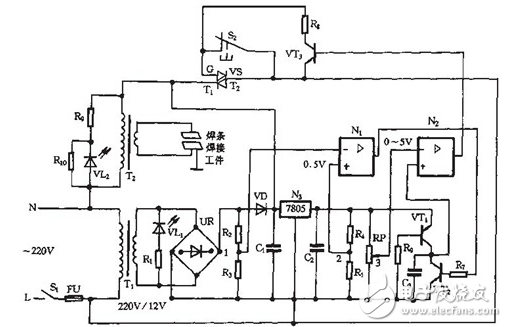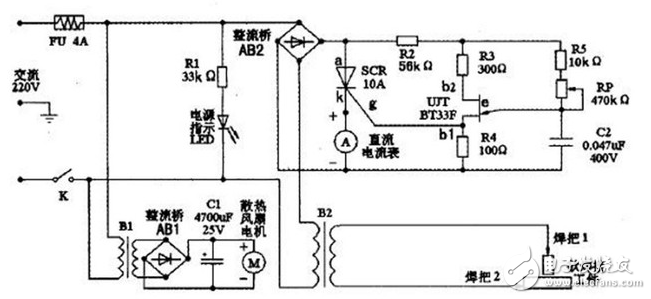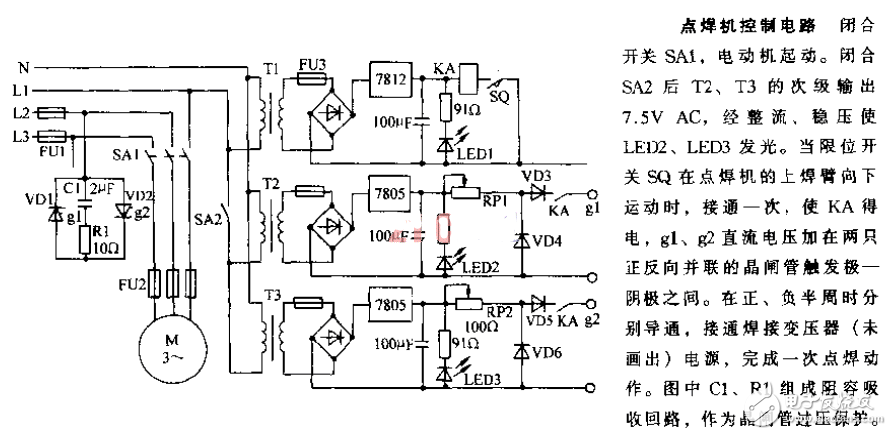
Privacy statement: Your privacy is very important to Us. Our company promises not to disclose your personal information to any external company with out your explicit permission.
The figure shows a main circuit and control circuit of a spot welder. Among them, the load controlled by the triac is a miniature spot welder for welding thin metal sheets. When working, the secondary side of the welding transformer T2 is welded to the working group or closed circuit. The current of hundreds of amps passes through the electrode instantaneously and concentrates on the tiny solder joints, which generates high heat, melts the metal, and completes the soldering. As shown below.

B2 is a step-down transformer. It is also the core component of the welding machine. The AB2 rectifier bridge, the unidirectional thyristor SCR, the single junction transistor UJT, the resistors R2, R3, R4, R5, the capacitor C2 and the potentiometer RP constitute a welding current stepless regulator. The DC ammeter A is used to indirectly indicate the magnitude of the welding operating current. The power indicator circuit is composed of LEDs. The small transformer B1, the rectifier bridge AB1, the capacitor C1, and the fan M constitute a heat dissipation system.
It can be seen from the figure that the device circuit is very simple. To be complicated, it can only be regarded as a current regulator. It uses the negative-impedance characteristics of a single-junction transistor to form a relaxation oscillator as a trigger circuit for a unidirectional thyristor. Since the power supply of the single-junction transistor relaxation oscillator is taken from the full-wave pulsating DC voltage output from the Bridge Rectifier circuit. When the thyristor is not turned on, the capacitor C2 of the relaxation oscillator is charged by R2, R5 and RP, and the voltage VC2 across the capacitor rises exponentially. When going to the peak-point voltage VP of a single junction transistor. The single junction transistor UJT is suddenly turned on, and the base region resistance RB1 is drastically reduced. Capacitor C2 is rapidly discharged to the resistor R4 through the PN junction, causing a positive transition of the voltage Vg across R4. A steep rising edge of the pulse is formed, and as the capacitor C2 discharges, VC2 decreases exponentially, and when it is lower than the valley voltage V, the single junction transistor is turned off.
The output of the R4 is a cusp trigger pulse. The thyristor SCR is turned on. An alternating current flows through the primary winding of B2, and the voltage drop across the thyristor becomes small, forcing the relaxation oscillator to stop working. When the AC voltage crosses zero, the thyristor is forced to turn off. The relaxation oscillator is energized again, and the capacitor C2 starts to charge again, so that the above process is repeated over and over again. Adjusting the potentiometer RP can change the charging time of the capacitor C2, that is, changing the oscillation period of the relaxation oscillator. Naturally, it changes the moment when the relaxation oscillator sends the first trigger pulse after each AC voltage zero-crossing. The conduction control angle of the thyristor SCR is changed accordingly, so that the voltage applied across the B2 primary winding changes. Finally, the purpose of regulating the secondary output current is adjusted.
Device selection and testing
The step-down transformer B2 selects the filament transformer of the end-of-life high-power amplifier tube FU-720F of the waste color TV transmitter. The primary AC voltage is 220V. The secondary AC voltage is 4V. Stable output current up to 80A. If you can't find a suitable low-voltage and high-current transformer like this, you can also make it yourself. First, find a 220V AC Power Transformer with a power of 300W or more and remove the original secondary winding coil. Another copper cable of 0,5 cm2 or more is wound around the transformer by 6 to 10 匝 to ensure that the output voltage is about 4V.
The single-junction transistor is BT33F, and the unidirectional thyristor is CR10AM. Before the actual production, it is necessary to check the quality of the pin electrode. For single junction transistors. First, determine the emitter e, put the pointer multimeter resistance file in the RX1k file, and use the two meter pens to measure the positive and negative resistances of any two electrodes are equal (about 2 to 1OkΩ), the two electrodes are b1 And b2, the remaining one electrode is the emitter e, then the first base b1 and the second base b2 are separated, the black meter is connected to the E pole, and the other two electrodes are sequentially contacted by the red test pen, and the forward resistance is measured respectively. value. Due to the construction of the tube, the second base b2 is close to the PN junction, so the forward resistance between the emitters e and b2 should be slightly smaller than the forward resistance between e and b1, ranging from a few to a few ten kΩ. Therefore, when the measured resistance is small, the electrode connected to the red test pen is b2. When the resistance is large, the red test pen is connected to b1. But even b1 and b2 are upside down. Under normal conditions, the tube will not be damaged. It only affects the amplitude of the output pulse; if the amplitude of the output pulse is found to be small. Simply swap the two bases together.
The unidirectional thyristor looks like a high-power triode. When the anode (a), cathode (k) and gate (g) three-electrode pins are discriminated. To use the pointer type multimeter R × 10 file. Measure the resistance and the remaining two feet
If they are unreachable (positive and negative resistance values are several hundred kilo ohms or more), they are A poles. Then measure the remaining two feet of resistance. When the resistance is small (about tens or hundreds of ohms). The black test pen is connected to the g pole. The other foot is k pole. If the test results do not match the above situation. Indicates that the component is broken.
The DC ammeter A can be replaced by an easy-to-buy milliampere meter followed by a long wire. The wire is equivalent to a small resistance shunt resistor. The specific length should be determined according to the actual use of the display situation. The cooling fan uses a common DC 12V computer fan, and the transformer B1 can take 10V. The resistor should be 2W or more, and the FU should be selected as a 250V, 4A fuse. Considering that the secondary output current is large, the soldering lead wire should be made of copper core wire and have sufficient cross section to ensure that it will not be burnt due to overload during use.
Finally, it should be noted that the circuit should be placed in a suitable metal casing after assembly. In addition to ensuring good ventilation, the entire circuit should be well insulated from the casing and the casing must be reliably grounded.


August 12, 2024
The full name thyratron, commonly known as thyristor, is a bistable power electronic device that contains 3 or more PN junctions that can switch from off-state to on-state or from on-state to...
When the thyristor damage need to check the analysis of the reasons, the core can be removed from the cooling jacket, open the core box and then remove the chip, observe the signs of damage to...
A special sealing device is made by the method of disposing the dust in the radiator. This kind of device only leaves the fan through hole. Go to the construction site and construction site to...
In order to prevent damage to the thyristor caused by the failure of the AC circuit inversion of the thyristor, the traditional method is to use a fast fuse for overcurrent protection. The advantage...
Email to this supplier
August 12, 2024
August 14, 2023
January 07, 2021

Privacy statement: Your privacy is very important to Us. Our company promises not to disclose your personal information to any external company with out your explicit permission.

Fill in more information so that we can get in touch with you faster
Privacy statement: Your privacy is very important to Us. Our company promises not to disclose your personal information to any external company with out your explicit permission.